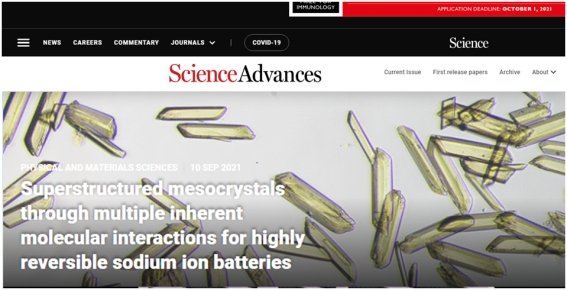The joint research team of Hao Wu, Yun Zhang and Junling Guo of the BMI Center for Biomass Materials and Nanointerfaces, took the basic structure unit of plant polyphenols as the core material and used its own special physicochemical properties to build the multi-layer mesomorphic structure. Consequently, the team has made important progress in the research of high-performance bismuth based sodium ion battery cathode materials. The researchers discovered thatnatural polyphenols are promising versatile “green” building blocks for engineering multifunctional supramolecular materials due to their ability to simultaneously exert multiple noncovalent interactions.
The research findings have been recently published in Science Advances as a cover article entitled “Superstructured Mesocrystals Through Multiple Inherent Molecular Interactions for Highly Reversible Sodium Ion Batteries”. The three first authors are Xiaoling Qiu, a Class 2021 doctoral student of the College of Materials Science and Engineering, Xiaoling Wang, a research associate of theCollege of Biomass Science and Engineering, and Yunxiang He, a research assistantof theCollege of Biomass Science and Engineering. The corresponding authors are Hao Wu, a research fellow of the College of Materials Science and Engineering; Yun Zhang, a professor of the College of Materials Science and Engineering; and Junling Guo, a professor of the College of Biomass Science and Engineering.

A cover article of the Journal

“Soft structures in nature, such as supercoiled DNA and proteins, can organize into complex hierarchical architectures through multiple noncovalent molecular interactions. Identifying new classes of natural building blocks capable of facilitating long-range hierarchical structuring has remained an elusive goal. We report the bottom-up synthesis of a hierarchical metal-phenolic mesocrystal where self-assembly proceeds on different length scales in a spatiotemporally controlled manner. Phenolic-based coordination complexes organize into supramolecular threads that assemble into tertiary nanoscale filaments, lastly packing into quaternary mesocrystals. The hierarchically ordered structuresare preserved after thermal conversion into a metal-carbon hybrid framework and can impart outstanding performance to sodium ion batteries, which affords a capability of 72.5 milliampere hours per gram at an ultrahigh rate of 200 amperes per gram and a 90% capacity retention over 15,000 cycles at a current density of 5.0 amperes per gram. This hierarchical structuring of natural polyphenols is expected to find widespread applications.” (Abstract)
Prof. Orlando J. Rojasn ofthe University of British Columbia, Canada and Prof.Ian Manners of theUniversity of Victoria, Canada, have participated in part of the research.
This work was supported by National Talents Program, Double First Class University Plan of Sichuan University, State Key Laboratory of Polymer Materials Engineering (grant no. sklpme2020-03-01), National Natural Science Foundation of China (21878192 and 51502180), the Fundamental Research Funds for the Central Universities (2016SCU04A18), Talents Program of Sichuan Province, Graduate Student’s Research and Innovation Fund of Sichuan University (2018YJSY070), China Postdoctoral Science Foundation (2020TQ0209), and so forth.
https://www.science.org/doi/10.1126/sciadv.abh3482
